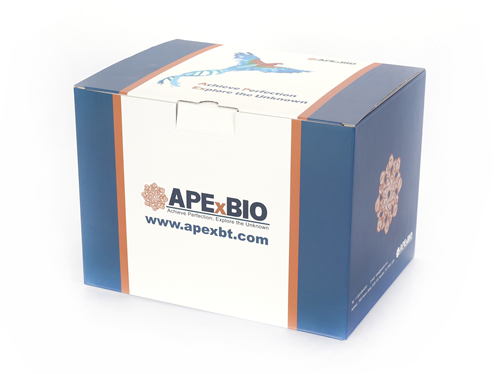PR-619
(2,6-diamino-5-thiocyanatopyridin-3-yl) thiocyanate, also designated as PR-619, is a broad-range reversible and cell-permeable inhibitor of deubiquitylating enzyme (DUB)[1][2][3], potently suppresses the activity of almost all cysteine protease DUBs[4], but shows selectivity toward DUBs over other proteases, such as calpain 1, or cathepsins[3]. PR-619 induces (tumor) cell death with EC50 values in the low micromolar range [1].
Deubiquitylating enzyme (DUB), also called ubiquitin isopeptidase or deubiquitinating proteins, performs deubiquitination of target proteins. Ubiquitination, followed by proteasomal degradation, is a process of ubiquitin proteasome system (UPS). Failure of the ubiquitin proteasome system (UPS) and/or the autophagy pathway may result in aggregation of proteins, a pathological hallmark of many neurodegenerative diseases [2].
In OLN-t40 cells, 7-10 μM as the concentration range for PR-619 to exert its cytotoxicity was suggested, half maximal cytotoxicity was observed after a 24h-treatment with 9-10 μM PR-619. Similar to MG-132, PR-619 caused an increase in the abundance of ubiquitinated proteins within 24 h at the concentration range of 7-12.5μM. Tested with OLN-t40 cells, PR-619, unlike MG-132, did not inhibit the enzymatic activity of the proteasome in cellular lysates but only when taken up by living cells[2]. An in vitro system showed that PR-619 was able to stabilize the microtubule network and led to small tau aggregates surrounding the microtubule organizing center [5].
There is still not any available result regarding in vivo treatment in an animal body.
References:
[1]. Mikael Altun, Holger B. Kramer, Lianne I. Willems, et al. Activity-Based Chemical Proteomics Accelerates Inhibitor Development for Deubiquitylating Enzymes. Chemistry & Biology, 2011, 18(11): 1401-1412.
[2]. Veronika Seiberlicha, Olaf Goldbauma, Victoria Zhukareva, et al. The small molecule inhibitor PR-619 of deubiquitinating enzymes affects the microtubule network and causes protein aggregate formation in neural cells: Implications for neurodegenerative diseases. Biochimica et Biophysica Acta (BBA) - Molecular Cell Research, 2012, 1823(11): 2057–2068.
[3]. Iraia García-Santisteban, Godefridus J Peters, Elisa Giovannetti, et al. USP1 deubiquitinase: cellular functions, regulatory mechanisms and emerging potential as target in cancer therapy. Molecular Cancer, 2013, 12:91.
[4]. Maria Stella Ritorto, Richard Ewan, Ana B. Perez-Oliva, et al. Screening of DUB activity and specificity by MALDI-TOF mass spectrometry. Nature Communications, 2014, 5:4763.
[5]. Laura J Blair, Bo Zhang and Chad A Dickey, et al. Potential synergy between tau aggregation inhibitors and tau chaperone modulators. Alzheimer's Research & Therapy, 2013, 5:41.
| Physical Appearance | A solid |
| Storage | Store at -20°C |
| M.Wt | 223.28 |
| Cas No. | 2645-32-1 |
| Formula | C7H5N5S2 |
| Solubility | insoluble in H2O; insoluble in EtOH; ≥11.15 mg/mL in DMSO |
| Chemical Name | (2,6-diamino-5-thiocyanatopyridin-3-yl) thiocyanate |
| SDF | Download SDF |
| Canonical SMILES | C1=C(C(=NC(=C1SC#N)N)N)SC#N |
| Shipping Condition | Small Molecules with Blue Ice, Modified Nucleotides with Dry Ice. |
| General tips | We do not recommend long-term storage for the solution, please use it up soon. |
| Cell experiment [1]: | |
|
Cell lines |
OLN-t40 cells; GFP-LC3-OLN cells |
|
Preparation method |
The solubility of this compound in DMSO is >10 mM. General tips for obtaining a higher concentration: Please warm the tube at 37℃ for 10 minutes and/or shake it in the ultrasonic bath for a while. Stock solution can be stored below -20℃ for several months. |
|
Reaction Conditions |
Indirect immunofluorescence assay: 18 h. |
|
Applications |
OLN-t40 cells were stably transfected with plasmids encoding the GFP-LC3 fusion protein, exposed to PR-619 (10 μM) for 18 h, and subjected to indirect immunofluorescence using antibodies against LC3. GFP-LC3-OLN cells were treated with PR-619 (9 μM) for 16 h. After, cells were incubated with LysoTracker Red (250 nM) for 30 min at 37℃. Results indicated that treatment with PR-619 represented a DUB inhibitor with broad specificity. Besides, PR-619 does not impair the autophagic flux. |
|
References: [1] Veronika Seiberlich, Janika Borchert, VIctora Zhukareva, Christiane Richter-Landsberg. Inhibition of Protein Debiquitination by PR-619 Activates the Autophagic Pathway in OLN-t40 Oligodendroglial Cells. Cell Biochem Biophys , 2013; 67:149–160. |
|
| Description | PR-619 is a non-selective, reversible inhibitor of the deubiquitinylating enzymes (DUBs) with EC50 of 1-20 μM. | |||||
| Targets | USP2 core | USP4 | USP20 | JOSD2 | DEN1 | |
| IC50 | 7.2 μM (EC50) | 3.93 μM (EC50) | 5.10 μM (EC50) | 1.17 μM (EC50) | 4.98 μM (EC50) | |
Quality Control & MSDS
- View current batch:
Chemical structure

Related Biological Data

Related Biological Data













